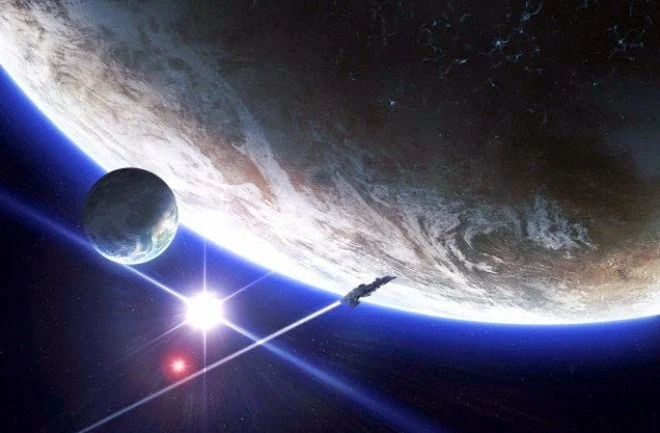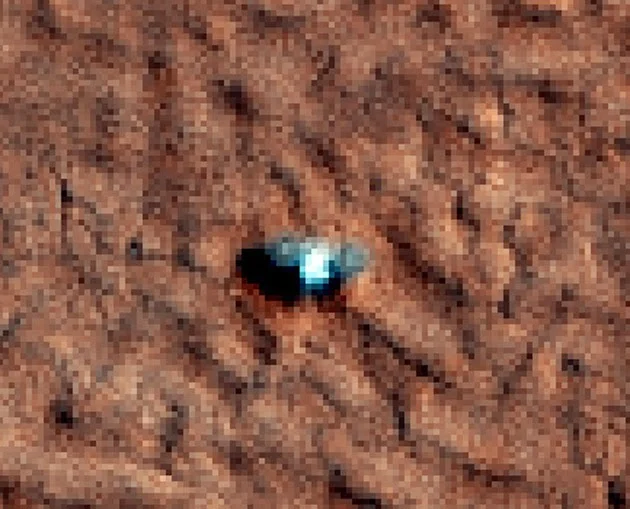Humanity will have
the tools to detect alien life in the next two decades, but whether scientists
can actually find life in another solar system depends a lot on luck, a panel
of experts said Wednesday (May 21).
Η
ανθρωπότητα στα επόμενα 20 χρόνια θα έχει την τεχνική δυνατότητα να ανιχνεύσει
εξωγήινη ζωή, αλλά το αν οι επιστήμονες πράγματι θα εντοπίσουν ζωή σε ένα άλλο
ηλιακό σύστημα θα εξαρτηθεί πολύ από την τύχη. Την άποψη αυτή διατύπωσε μια
ομάδα εμπειρογνωμόνων πριν από μια εβδομάδα.
The James Webb
Space Telescope (JWST) is the successor to the Hubble Space Telescope, and it
will be almost three times the size of Hubble. JWST has been designed to work
best at infrared wavelengths. This will allow it to study the very distant
Universe, looking for the first stars and galaxies that ever emerged. Credit:
ESA
Ενώ
το 2018 αναμένεται να μπει σε τροχιά το διαστημικό τηλεσκόπιο James Webb, που θα είναι σε θέση να ερευνήσει για τις
χημικές υπογραφές της ζωής στις ατμόσφαιρες εξωπλανητών, δεν είναι σίγουρο ότι
οι επιστήμονες θα βρουν εξωγήινη ζωή κάπου στο σύμπαν.
A sci-fi imagining
of an alien civilization -- where are the intelligent aliens of sci-fact?
Σύμφωνα
με τους επιστήμονες που έλαβαν μέρος στο αμερικανικό εθνικό συμπόσιο για το
διάστημα, ο εντοπισμός είναι δύσκολος γιατί κανείς δεν είναι σίγουρος για το
πώς η ζωή αρχίζει ή για το αν είναι πανταχού παρούσα.
17 percent of the
stars surveyed by NASA's Kepler space telescope have Earth-sized worlds in
orbit, underlining the preponderance of small exoplanets in our galaxy. Credit:
David A. Aguilar (CfA)
Σύμφωνα
με τον John Grünsfeld, υποδιευθυντή επιστημονικών αποστολών της NASA: «Δεν
γνωρίζουμε πόσους πλανήτες θα χρειαστεί να εξετάσουμε πριν βρούμε ζωή, και αν
δε βρούμε στους πρώτους 10 ή 100, δε θα σημαίνει πως δεν υπάρχει. Αυτό είναι το
δύσκολο».
The radio signal
detected by the 100-meter Green Bank Telescope in West Virginia while scanning
the exoplanetary candidate KOI 817. This is the kind of signal SETI scientists
would expect to find if an alien civilization is transmitting. There have been
a few false alarms when listening out for a SETI signal. As we're looking for a
specific, narrow-band radio signal (something that could only be generated by a
form of technology), terrestrial interference can show up in SETI searches.
Fortunately, astronomers are a savvy bunch and usually know the difference
between aliens and Aunt Sally gossiping on her cellphone. Credit: UC
Berkeley/SETI
Η
κατασκευή νέων, ισχυρότερων διαστημικών τηλεσκοπίων θα βοηθήσει τους ερευνητές
να δουν περισσότερα άστρα, αυξάνοντας τις πιθανότητες εύρεσης ιχνών ζωής στην
ατμόσφαιρα εξωπλανήτη – όπως το οξυγόνο που παράγεται από φυτά ή το μεθάνιο.
Artist's impression
of HP 56948. Forget "habitable exoplanets" for now -- how about
directing a search at stars that are similar in temperature, size and chemical
composition to our sun? The sun, after all, provides our planet with energy,
and all the chemicals that form our planet came from the protoplanetary disk
surrounding our newborn star 4.5 billion years ago... why not just look for
sun-like stars? Well, in 2012, astronomers discovered HP 56948 -- the sun's
"clone" only 200 light-years away. Although no exoplanets have been
discovered in orbit so far, it's interesting to ponder whether to target
"Earth-like" planets or "sun-like" stars as potentially
habitable places for alien civilizations. Credit: ESO
Σύμφωνα
με την Sara Seager αστροφυσικό του MIT που ψάχνει για εξωπλανήτες: «Δεν μπορούμε να πούμε τι ακριβώς είναι η ζωή
και το μόνο που μπορούμε να κάνουμε είναι να εργαστούμε με αυτό που κάνει η
ζωή. Η ζωή μεταβολίζει και παράγει αέρια και αυτά είναι που ψάχνουμε … Τα καλά
νέα είναι, πως ότι κι αν είναι η ζωή, εφόσον χρησιμοποιεί τη χημεία, θα είμαστε
σε θέση να την εντοπίσουμε».
A sunflower-shaped
'starshade' launched to space with a simple telescope could help scientists on
the ground hunt for another Earth. Credit: NASA/JPL/Caltech
Μια
αποστολή που βρίσκεται ακόμα στα πρώτα στάδια ανάπτυξης θα μπορούσε επίσης να
βοηθήσει τους επιστήμονες να ερευνήσουν για εξωγήινους κόσμους, ακόμη και χωρίς
τη χρήση ενός μεγάλου τηλεσκοπίου, ονομάζεται «starshade». Ένα διαστημικό σκάφος που μοιάζει με
γιγαντιαίο ηλιοτρόπιο, θα κρύβει το φως του άστρου-ήλιου, επιτρέποντας έτσι στο
κατάλληλα τοποθετημένο διαστημικό τηλεσκόπιο, να παρατηρεί τις ατμόσφαιρες των
πλανητών που βρίσκονται σε τροχιά γύρω από το άστρο-ήλιο.
A protytpe
"petal" for a giant starshade being studied by NASA for a future
planet-hunting mission. The petals would unfold in space to block the light of
distant stars so an accompanying telescope can attempt to directly image alien
planets. Credit: NASA/Doug Lisman
Με
την χρήση του starshade,
σύμφωνα με τους επιστήμονες είναι πολύ πιθανό μέσα στις επόμενες δύο δεκαετίες,
να εντοπιστούν ίχνη ζωής σε έναν εξωπλανήτη παρόμοιο με τη Γη.
NASA's Mars Phoenix
lander as seen from orbit. Why stop at the moon? If an advanced alien species
has cruised through the solar system at some point in our sun's history,
perhaps they left some artifacts littered about the solar system. Credit: NASA/JPL-Caltech
Βέβαια,
εκτός από την πιθανή ύπαρξη μορφών ζωής σε εξωπλανήτες, υπάρχει και η
πιθανότητα εύρεσης εξωγήινης ζωής και μέσα στο ίδιο το ηλιακό μας σύστημα. Όπως
για παράδειγμα στον ωκεανό της Ευρώπης, του δορυφόρου του Δία, ή στον Άρη την
επιφάνεια του οποίου ερευνά ήδη το Curiosity.
The spiral galaxy
M51 -- see any bubbles of darkness? Could the absence of stars in a galaxy
reveal the presence of immense alien technology? Why not! In 1964, Soviet
astronomer Nikolai Kardashev hypothesized that some alien civilizations may
become so advanced that they utilize all the energy coming from a star. Such
extraterrestrial civilizations are known as "Type II" on the
Kardashev scale. How can they do this? Well, by creating the sci-fi favorite
Dyson Sphere around a star. This shell would collect all the energy from the
star, thus hiding it to any outside observer. From our perspective, if we saw a
lack of star light in dark pockets in nearby galaxies, perhaps that's due to
these types of civilizations constructing huge spheres around stars. Credit: NASA,
ESA
Για
τους ερευνητές είναι πολύ σημαντικό να εντοπίσουν ένα πρώτο παράδειγμα
εξωγήινης ζωής. Αν βρουν ένα, τότε θα μπορούν να ισχυριστούν ότι η ζωή είναι
τελικά νόμος του σύμπαντος.











Δεν υπάρχουν σχόλια:
Δημοσίευση σχολίου